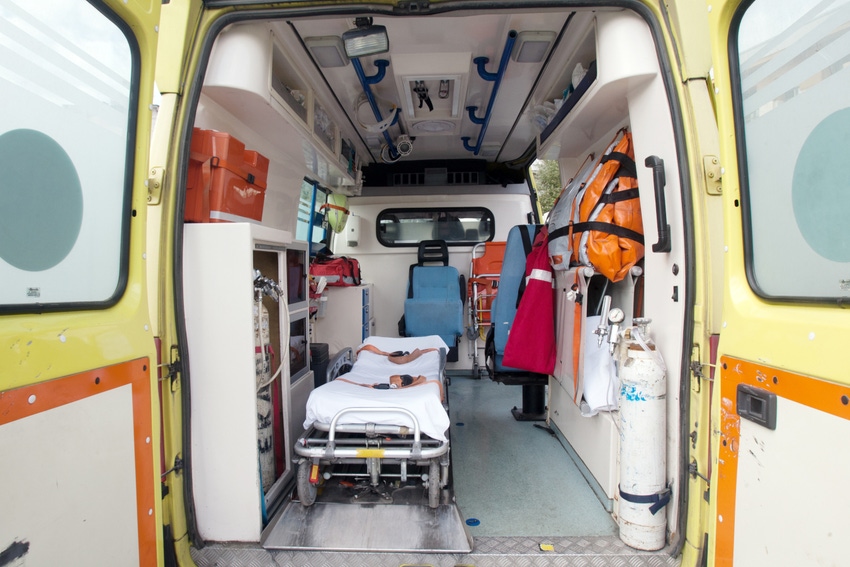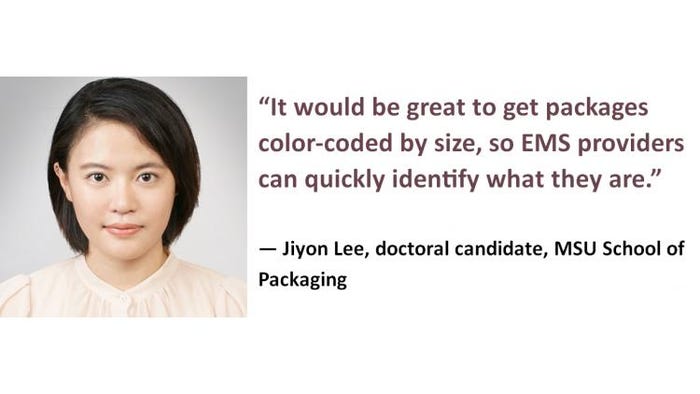Immersive research homes in on paramedics’ packaging needs

The context in which a package is used should always be a consideration in packaging design—and never more so than when the product in question is designed for emergency medical care in an ambulance or other prehospital setting.
Jiyon Lee, a doctoral candidate in the Michigan State University (MSU) School of Packaging, will delve into that subject in a presentation at Healthcare Packaging Immersion Experience (HcPIE) 2019, to be held Oct. 9-10 at the James B. Henry Center in East Lansing, MI.
At HcPIE, medical packaging professionals and healthcare practitioners come together for a collaborative, active-learning experience. The event is held at a state-of-the-art healthcare-simulation facility at MSU, and its goal is to create optimal patient outcomes and improve the healthcare system overall. The School of Packaging hosts HcPIE.
Lee’s presentation, entitled “Human Factors Analysis Meets Immersive Simulation—How Context Impacts Behaviors of Healthcare Professionals,” draws upon her doctoral work, which focuses on how context affects packaging users in prehospital settings.
She has conducted a usability study to investigate how emergency medical services (EMS) providers interact with packaging in worst-case scenarios during which, for example, severe vehicular vibration may play a role and/or the patient’s condition may be critical.
Jiyon also has industry experience in Korea as a packaging engineer. Below, she answers Packaging Digest’s questions about the research behind her HcPIE 2019 presentation.
What is the difference between a prehospital setting and a perioperative setting?
Lee: The main difference between those two settings is that the prehospital setting is more to stabilize patients within a mobile vehicle (mostly), so it’s comparatively more urgent and chaotic, whereas the perioperative setting is to prepare for an operation, so it’s comparatively calm.
What types of medical products and packaging are used in these settings?
Lee: In the prehospital setting, the types of products and packaging are dependent upon the licensure level of the ambulance, such as basic life support (BSL) and advanced life support (ASL), as well as the medical authority of the county. However, they do not use the surgical devices that are usually used in operating rooms.
Intravenous (IV) start kits, IV tubing, IV solutions, IV catheters, gauze, 4-inch x 4-inch gauze pads and endotracheal tubes (so-called ET tubes) are the products of interest in my doctoral work.
How could changes to the medical packaging used in these settings improve healthcare outcomes?
Lee: According to the results of my survey, 21 % (n=359) and 17% (n=290) of the respondents (n=1,702) to our survey reported difficulties identifying medication and medical devices, respectively. Also, 20% (n=340) and 24% (n=399) of the respondents reported that they have difficulty opening medication/medical devices, respectively.
In addition to challenging care providers, this can cause a negative impact on patient care; in the survey, 6% (n=20) / 11% (n=31) and 9% (n=32) / 13% (n=51) of respondents reported that they have difficulty identifying medication/medical supplies and opening medication/medical supplies, respectively. Thus, from the results shown here, if we could improve design safely and effectively for EMS providers, we could reduce the negative impact.
Also, I believe packaging changes can help to reduce sterility issues throughout the process of patient care. Methicillin-resistant Staphylococcus aureus (MRSA) bacterium has been found on some areas in ambulances (Rago, Buhs, et al., 2012), and healthcare personnel’s hands tend to be the most common carrier for transmitting microorganisms that cause Hospital Acquired Infection (HAI) (Allegranzi, Nejad, et al., 2017). So, no matter how well the sterile barrier system (SBS) is built, EMS providers and patients could be at risk.
From the survey study, 39% of respondents employ “use of teeth” as a coping strategy when they have difficulty opening medical-device packaging. This may lead to additional infections in EMS providers, because they may grab/open the package with their teeth, using the area of the package that their contaminated hands touched. To reduce this issue, packaging could provide one-handed opening so they would not need to use their teeth to open packages.
Your presentation at HcPIE will include the results of an ambulance contamination test. How did you perform this test?
Lee: For this test, clue spray was used. The spray is visible under black light but invisible to the naked eye. We applied this spray to areas where MRSA has been found within an ambulance, according to Rago et al. (2012). We wanted to see where this simulant (clue spray) was transferred to. We found some transfers, such as near the simulated wound on a simulated patient and on the outside of packaging or products.
In what ways do care providers in non-hospital settings interact differently with medical packaging than their peers who work at hospitals?
Lee: They resort to using their teeth or sharp tools (trauma shears, pens or knives) to open packages. Also, to identify packages, they use flashlights; change the location of products within storage areas, jump bags or the ambulance; touch/feel the package; or use a marker on packages.
Storage of medical products on ambulances is obviously different from storage at a hospital. How can package designs be changed to better meet ambulance-storage needs?
Lee: Generally, most of the products they carry to an emergency scene are stored in a jump bag. In this bag, the products are nicely organized, but from my observation, it is hard to identify the size of products (for example, an ET tube) at a glance. Thus, it would be great to get packages color-coded by size, so EMS providers can quickly identify what they are.

What point-of-use considerations should a packaging engineer take into account when designing packaging for non-hospital environments?
Lee: Prehospital settings are comparatively urgent, so patient care needs to be safely and efficiently provided. In this setting or context, needing extra time to identify/open/remove packaging is not a good idea.
From my survey results, 80% of respondents are male. Considering this characteristic, packaging needs to be changed. Generally, males’ thumbs—the dominant finger used to separate a package’s layers—are bigger than the area that they can grip on the packaging (most of the packages in an ambulance are either form-fill-seal or flexible plastic pouches). So, providers need more time to separate the two layers and open packaging in an urgent situation. Packaging engineers need to take this gender characteristic into account.
In your survey of EMS personnel, what did they dislike about current medical packaging?
Lee: With regard to medication, more than 50% of respondents reported that they have difficulty identifying medication when “Different medications have similar packaging” and “Small text on label made it difficult to read.”
Also, about 60% of respondents reported that they have difficulty opening medication when a “Product required two hands to open,” there was “Too small of an area to grip” and the “Product required too much force to open.”
With regard to medical device packaging, “Crowded label made it difficult to read” and “Different supplies had similar packaging” were the two highest rated choices among the difficulties experienced in identifying packaging.
Also, when they open medical device packaging, “Product required two hands to open” and “Too small of an area to grip” were the difficulties 65% of the time.
About the Author(s)
You May Also Like




